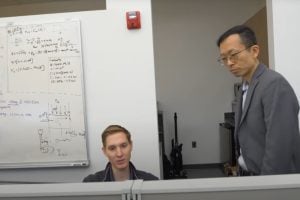
Thunderstorms, dust storms, and volcanic eruptions can lead to large, fantastic displays of lightning where tiny particles—like ice, ash, and dust—collide and gain both negative and positive electrical charges, leading to an imbalance that releases a bolt of energy.
Although these collisions happen naturally, sudden changes in the environment can cause chaotic air movement known as turbulence, a key factor in building up enough electric potential for lightning, according to Rui Ni, an associate professor of mechanical engineering at the Whiting School of Engineering.
“We think that turbulence could increase the chance of lightning simply because it causes more collisions and separates the charges much faster, thereby increasing the overall electrostatic field,” he says. “That’s why we want to replicate what’s happening in the cloud and understand the fundamental physics.”
“Turbulence is one of the hardest problems in fluid dynamics,” he adds. “It generates a countless number of swirling, chaotic motions that constantly interact and evolve, making it incredibly challenging to predict.”
Funded by the Gordon and Betty Moore Foundation, Ni and his research group are reproducing and studying electrical storms in their lab to test his hypothesis. He says that by knowing how turbulence affects charged particles, meteorologists can create more accurate models to predict when and where lightning will strike to better protect aircraft, prevent wildfires, and understand climate patterns.
The study’s findings could also improve industrial processes facing the same fundamental problem: particles moving within a powerful air or gas flow. Some examples include controlling air pollution, preventing buildup in jet engines, and manufacturing powders for almost every industry, including pharmaceuticals.
“Powder manufacturers often use high-pressure air to transport the products in their facility,” says doctoral candidate Matt Gorman. “That naturally causes a huge amount of particle collisions, and if they’ve got the wrong conditions, that could end in an explosion,” says Gorman, who joined Ni’s research team in 2020.
Ni is one of 19 researchers named to the 2024 cohort of the Moore Foundation’s Experimental Physics Investigator Initiative, which awards scientists a five-year, $1.25 million grant for experimental research that may be hard to fund through traditional funding sources. The support allows investigators to explore new and uncharted areas to advance the field of physics.
One of Ni’s experimental facilities is a clear three-foot square chamber with fans in its eight corners that produces an airflow similar to turbulence in clouds during a storm. On top are two funnels lined with electrical wire where, during a test, they pour in dust-like glass beads to gain a particular charge before rapidly swirling around in the chamber. A high-speed camera in front captures and sends thousands of photos per second to their nearby computer, allowing Ni’s team to track and measure how fast each particle travels. This chamber is where they hope to see sparks.
“Once we can charge particles to an extreme extent, we want to see what scale we can generate lightning or at least measure the electrical field to inform if it could lead to lightning, then compare that to what we observe in nature,” Ni says.
“Although it is straightforward to generate discharges by applying high voltages, providing an environment where discharges emerge from particle-laden turbulence requires a careful control of both the environment and particle collisions,” he adds, referencing how particle size and roughness can lead to vastly different outcomes.
This project stemmed from Ni’s earlier work looking specifically at particle buildup in jet engines. The Moore Foundation’s grant has allowed him to expand the scope of his research, maintain equipment, test different charging methods, and hire a team of student researchers.
“The foundation’s support is critical in making sure that experimental discoveries can be continued,” Ni says. “Turbulence simulations based on classical fluid dynamics equations, like Navier-Stokes, may not capture all the complexities introduced by particle motions and electrostatic effects. That’s where experiments become essential. They can reveal new phenomena, uncover unexplored regimes, and drive groundbreaking innovations.”
Ni also emphasizes that his team has been crucial to the lab’s progress. Similarly, Gorman, who will graduate this spring, says being involved with this research has been one of the best parts of his career.
“It’s been extremely formative to me to grow alongside great mentors and people that have a passion, curiosity, and drive to make a difference,” Gorman says.
“The fact that the Moore Foundation is willing to fund this project is extremely affirming that we’re asking the right questions and that our research will make an impact that extends way beyond this lab,” he adds.